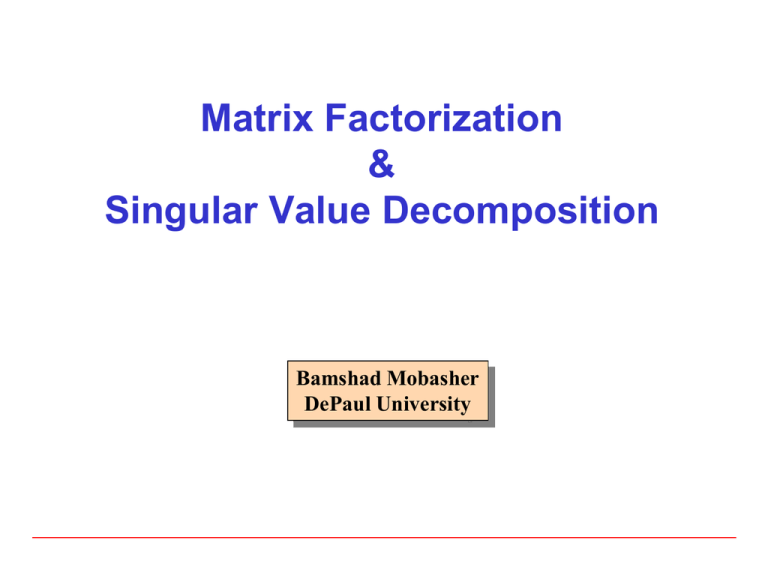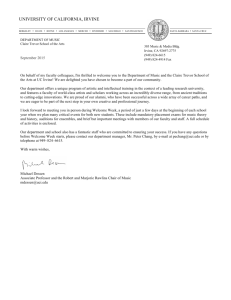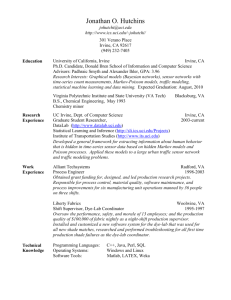SVD - DePaul University
advertisement

Matrix Factorization & Singular Value Decomposition Bamshad Mobasher DePaul University Matrix Decomposition Matrix D = m x n e.g., Ratings matrix with m customers, n items e.g., term-document matrix with m terms and n documents Typically D is sparse, e.g., less than 1% of entries have ratings n is large, e.g., 18000 movies (Netflix), millions of docs, etc. So finding matches to less popular items will be difficult Basic Idea: compress the columns (items) into a lower-dimensional representation Credit: Based on lecture notes from Padhraic Smyth, University of California, Irvine 2 Singular Value Decomposition (SVD) D m where: x n = U m x n S Vt n x n n x n rows of Vt are eigenvectors of DtD = basis functions S is diagonal, with dii = sqrt(li) (ith eigenvalue) rows of U are coefficients for basis functions in V (here we assumed that m > n, and rank(D) = n) Credit: Based on lecture notes from Padhraic Smyth, University of California, Irvine 3 SVD Example Data D = 10 20 10 2 5 2 8 17 7 9 20 10 12 22 11 Credit: Based on lecture notes from Padhraic Smyth, University of California, Irvine 4 SVD Example Data D = 10 20 10 2 5 2 8 17 7 9 20 10 12 22 11 Note the pattern in the data above: the center column values are typically about twice the 1st and 3rd column values: So there is redundancy in the columns, i.e., the column values are correlated Credit: Based on lecture notes from Padhraic Smyth, University of California, Irvine 5 SVD Example Data D = 10 20 10 2 5 2 8 17 7 9 20 10 12 22 11 D = U S Vt where U = 0.50 0.14 -0.19 0.12 -0.35 0.07 0.41 -0.54 0.66 0.49 -0.35 -0.67 0.56 where S = 48.6 0 0 0.66 0 1.5 0 0.27 0 0 1.2 and Vt = 0.41 0.82 0.40 0.73 -0.56 0.41 0.55 0.12 -0.82 Credit: Based on lecture notes from Padhraic Smyth, University of California, Irvine 6 SVD Example Data D = 10 20 10 2 5 2 8 17 7 9 20 10 12 22 11 D = U S Vt where U = 0.50 0.14 -0.19 0.12 -0.35 0.07 0.41 -0.54 0.66 0.49 -0.35 -0.67 0.56 Note that first singular value is much larger than the others where S = 48.6 0 0 0.66 0 1.5 0 0.27 0 0 1.2 and Vt = 0.41 0.82 0.40 0.73 -0.56 0.41 0.55 0.12 -0.82 Credit: Based on lecture notes from Padhraic Smyth, University of California, Irvine 7 SVD Example Data D = 10 20 10 2 5 2 8 17 7 9 20 10 12 22 11 D = U S Vt where U = 0.50 0.14 -0.19 0.12 -0.35 0.07 0.41 -0.54 0.66 0.49 -0.35 -0.67 0.56 Note that first singular value is much larger than the others where S = 48.6 0 0 0.66 0 1.5 0 0.27 0 0 1.2 and Vt = 0.41 0.82 0.40 0.73 -0.56 0.41 0.55 0.12 -0.82 First basis function (or eigenvector) carries most of the information and it “discovers” the pattern of column dependence Credit: Based on lecture notes from Padhraic Smyth, University of California, Irvine 8 Rows in D = weighted sums of basis vectors 1st row of D = [10 20 10] Since D = U S V, then D[0,: ] = U[0,: ] * S * Vt = [24.5 0.2 -0.22] * Vt Vt = 0.41 0.82 0.40 0.73 -0.56 0.41 0.55 0.12 -0.82 D[0,: ] = 24.5 v1 + 0.2 v2 + -0.22 v3 where v1 , v2 , v3 are rows of Vt and are our basis vectors Thus, [24.5, 0.2, 0.22] are the weights that characterize row 1 in D In general, the ith row of U* S is the set of weights for the ith row in D Credit: Based on lecture notes from Padhraic Smyth, University of California, Irvine 9 Summary of SVD Representation D = U S Vt Data matrix: Rows = data vectors Vt matrix: Rows = our basis functions U*S matrix: Rows = weights for the rows of D Credit: Based on lecture notes from Padhraic Smyth, University of California, Irvine 10 How do we compute U, S, and V? SVD decomposition is a standard eigenvector/value problem The eigenvectors of Dt D = the rows of V The eigenvectors of D Dt = the columns of U The diagonal matrix elements in S are square roots of the eigenvalues of Dt D => finding U,S,V is equivalent to finding eigenvectors of DtD Solving eigenvalue problems is equivalent to solving a set of linear equations – time complexity is O(m n2 + n3) Credit: Based on lecture notes from Padhraic Smyth, University of California, Irvine 11 Matrix Approximation with SVD ~ U D ~ m where: x n m x k S Vt k x k k x n columns of V are first k eigenvectors of DtD S is diagonal with k largest eigenvalues rows of U are coefficients in reduced dimension V-space This approximation gives the best rank-k approximation to matrix D in a least squares sense (this is also known as principal components analysis) Credit: Based on lecture notes from Padhraic Smyth, University of California, Irvine 12 Collaborative Filtering & Matrix Factorization 17,700 movies 1 3 4 3 5 4 The $1 Million Question 5 5 5 2 2 3 480,000 users 3 2 5 2 3 1 1 1 3 User-Based Collaborative Filtering Item1 Item 2 Item 3 Item 4 Alice 5 2 3 3 User 1 2 User 2 2 User 3 User 4 User 7 Item 6 Correlation with Alice ? 4 4 1 -1.00 1 3 1 2 0.33 4 2 3 1 .90 3 3 2 1 0.19 2 -1.00 User 5 User 6 Item 5 5 2 3 3 2 2 3 1 3 5 1 5 Prediction 2 1 Best 0.65 match -1.00 Using k-nearest neighbor with k = 1 14 Item-Based Collaborative Filtering Item1 Item 2 Item 3 Alice 5 2 3 User 1 2 User 2 2 1 3 User 3 4 2 3 User 4 3 3 2 User 5 User 6 5 User 7 Item similarity 0.76 Item 4 Prediction 4 Item 5 3 Item 6 ? 4 1 1 2 2 1 3 1 3 2 2 2 3 1 3 2 5 1 5 1 0.79 0.60 Best 0.71 match 0.75 • Item-Item similarities: usually computed using Cosine Similarity measure 15 Matrix Factorization of Ratings Data ~ m users m users n movies P Q f n movies x f R rui pu~qTi Based on the idea of Latent Factor Analysis Identify latent (unobserved) factors that “explain” observations in the data In this case, observations are user ratings of movies The factors may represent combinations of features or characteristics of movies and users that result in the ratings 16 Matrix Factorization Pk Dim1 Dim2 Alice 0.47 -0.30 Bob -0.44 0.23 Mary 0.70 -0.06 Sue 0.31 0.93 QkT Prediction: Dim1 -0.44 -0.57 0.06 0.38 0.57 Dim2 0.58 -0.66 0.26 0.18 -0.36 ˆrui pk ( Alice ) qkT ( EPL) Note: Can also do factorization via Singular Value Decomposition (SVD) • SVD: M k U k S k Vk T Lower Dimensional Feature Space 1 Sue 0.8 0.6 0.4 Bob 0.2 Mary 0 -1 -0.8 -0.6 -0.4 -0.2 0 0.2 0.4 -0.2 -0.4 -0.6 -0.8 -1 Alice 0.6 0.8 1 Learning the Factor Matrices Need to learn the user and item feature vectors from training data Approach: Minimize the errors on known ratings Typically, regularization terms, user and item bias parameters are added Done via Stochastic Gradient Descent or other optimization approaches








